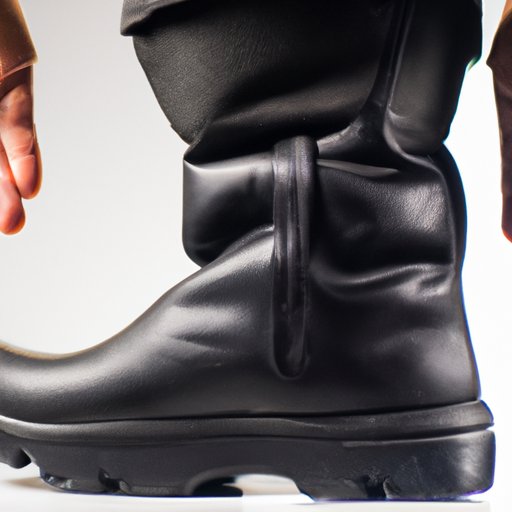
I. Introduction
Breaking in a new pair of boots can often be a frustrating process. With stiffness, blisters, and soreness, it’s no wonder many people dread it. However, breaking in boots doesn’t have to be painful. In this article, we’ll explore tips and tricks to break in boots faster with less pain and discomfort.
II. 7 Simple Steps to Break In New Boots Faster
Here are 7 simple steps to break in your new boots faster:
- Wear your boots around the house for short periods of time: Start by wearing your boots for short periods of time inside the house. This will allow the boots to begin molding to your feet in a comfortable environment.
- Use thick socks and/or insoles to cushion your feet: Thick socks and insoles can help cushion your feet and reduce the amount of friction between your skin and the boots. This reduces the likelihood of blisters and soreness.
- Apply heat to the boots to soften the leather: You can use a hairdryer to apply heat to specific areas of the boots that feel especially stiff. This will help soften the leather and make it more pliable.
- Use a boot stretching spray: A boot stretching spray can help loosen up tight spots in the leather that are causing discomfort. Simply apply the spray to the affected areas and wear the boots until they dry.
- Apply leather conditioner to soften the leather: Leather conditioner can help soften the leather and keep it supple. Apply it to the boots using a soft cloth or sponge and allow it to dry completely.
- Walk on various surfaces to help the boots mold to your feet: Walking on different surfaces can help the sole of the boot flex and mold to the shape of your foot.
- Repeat the process until the boots are comfortable: Breaking in boots can take time, so be patient. Repeat these steps until your boots feel comfortable.
III. Breaking in Boots: Don’t Let Pain Stand in Your Way
While breaking in boots, you may experience discomfort such as blisters and soreness. Here are some tips for managing pain:
- Use moleskin or bandages: Applying moleskin or bandages to areas of the feet that are prone to blisters and soreness can help reduce friction and cushion the skin.
- Take breaks: If you’re experiencing discomfort, take a break from wearing your boots to give your feet time to recover.
- Use painkillers: Over-the-counter painkillers such as ibuprofen or acetaminophen can help alleviate any pain or discomfort you may be experiencing.
IV. Boot Break-In Hacks: How to Soften Leather Quickly
If you want to soften leather quickly, here are a few unconventional methods:
- Use potato peels: Place potato peels inside the boots overnight. The acidity in the peels will help soften the leather.
- Use rubbing alcohol: Apply a small amount of rubbing alcohol to a soft cloth and gently rub it into the areas that need to be softened. Allow the boots to dry completely.
- Use a mixture of vinegar and water: Combine equal parts vinegar and water in a spray bottle. Spray the mixture onto the areas of the boots that need to be softened and use a soft cloth to work it into the leather.
V. No Pain, No Gain: Tips for Breaking In Leather Boots
Breaking in leather boots is necessary if you want them to be comfortable and durable in the long run. Here are some tips to minimize pain and discomfort:
- Choose boots that fit well: Boots that are too tight or too big will be uncomfortable, so be sure to choose a pair that fits well from the start.
- Invest in high-quality boots: High-quality boots are more likely to mold to your feet and last longer than cheaper, lower-quality boots.
- Break in boots gradually: Don’t try to wear your boots for extended periods of time right away. Gradually increase the amount of time you wear them to give your feet time to adjust.
VI. Comfortable from Day One: A Guide to Breaking In Boots
If you’re looking for boots that require minimal breaking in, here are some tips:
- Choose boots made from soft leather: Soft leather is more pliable and will require less breaking in than stiff leather.
- Choose boots with a flexible sole: A flexible sole will allow the boot to mold to your foot more easily.
- Choose boots with a padded footbed: A padded footbed will provide more cushioning and reduce the likelihood of blisters and soreness.
VII. Breaking In Boots: Patience Pays Off
Breaking in boots can be a frustrating process, but it’s important to be patient. In the end, it will be worth it.
VIII. Boot Break-In Mistakes: Avoiding Common Pitfalls
Here are some common mistakes people make while breaking in boots:
- Using too much conditioner: Applying too much conditioner to your boots can cause them to become too soft and lose their shape.
- Walking too far at once: Don’t try to break in your boots by going on a long hike right away. Gradually increase the distance you walk to give your feet time to adjust.
- Not wearing the right socks: The wrong socks can cause blisters and discomfort. Be sure to wear socks that fit well and are made from breathable fabric.
IX. Conclusion
Breaking in boots doesn’t have to be a painful process. By following these tips and tricks, you can break in your boots faster and with less discomfort. Remember to be patient, choose boots that fit well, and take breaks as needed. Before you know it, your boots will be comfortable and ready for any adventure.





